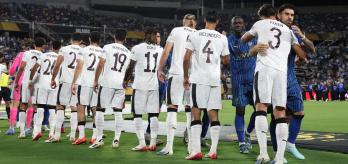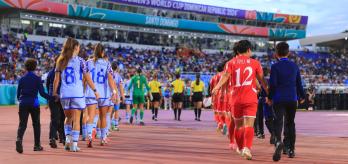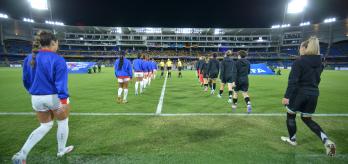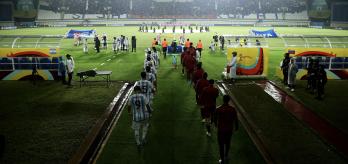Key take-aways
- Regarding year of birth, players born in 2007 represented the largest class with 64.6% while just 7.7% of the 336 selected players were born in 2009. The youngest of these participants was England’s Jane Oboavwoduo (14 years, 10 months and 18 days at the beginning of the competition).
- 88.7% of players who participated at the FIFA U-17 Women’s World Cup 2024 competed for clubs affiliated with the association. The highest percentages were recorded by CAF (100.0%) and the AFC (98.4%), and the lowest by Concacaf (68.3%).
- The Relative Age Effect (RAE) was small across all participants at the FIFA U-17 Women’s World Cup 2024, with 28.3% of the selected players being born in the initial quarter of the year (January, February, March) and 26.5% being born in the final quarter of the year (October, November December).
Introduction
This article is the result of a research project carried out jointly by FIFA High Performance and the CIES Football Observatory research group. This study analyses the composition of the national teams that qualified for the FIFA U-17 Women’s World Cup Dominican Republic 2024™ which took place from 16 October to 3 November 2024. To do this, we analysed the dates of birth of the 336 players selected, their clubs and leagues of employment.
The 16 qualified associations represent all confederations, with three participants for each, except for the OFC with only one. Four associations participated in a FIFA U-17 Women’s World Cup final tournament for the first time (the Dominican Republic, Ecuador, Kenya, and Poland), while four participating nations have previously secured the championship title, namely Korea DPR and Spain (on two occasions each) as well as Korea Republic and Japan (once).
What year were players born?
An analysis of the dates of births of the selected players allows for an understanding of their distribution by year and month of birth. In terms of year of birth, players born in 2007 represented the largest class with 64.6%, with the remaining 35.4% of players born in later years. Among the 26 players born in 2009, English forward Jane Oboavwoduo was the youngest (14 years, 10 months and 18 days at the beginning of the competition).
CAF and CONMEBOL tend to select younger players than other confederations. Specifically, more than half of the players in the African associations, and more than 42% of those in CONMEBOL, were born in 2008.
The analysis by month of birth allows for the testing of the Relative Age Effect (RAE). This concept refers to the typical over-representation of players born in the months immediately preceding the selected limit for defining an age category. In this case, the selection cut-off date is January. These players are generally at a competitive advantage due to their more advanced age as well as physical and psychosocial development compared to players born later in the year.
When the twelve months are divided into four birth quartiles, overall, there was a small effect across the sample, with 28.3% of players being born in the initial quarter of the year (i.e. January, February, and March), compared to 23.2% in the second quarter and 22.0% in the third quarter, but 26.5% in the final quarter (i.e. October, November, and December).
When the data is observed at the confederation level, there is an over-representation of players born in the first quarter of the year in the OFC (42.9%), UEFA (36.5%) and CONMEBOL (30.2%). Interestingly, CAF and the Concacaf had an over-representation in the fourth quarter, with 41.3% and 27.0%, respectively. The AFC is in an intermediate position, with a maximum of players born in quarter three (31.7%) but a minimum in quarter four (17.5%). This reflects the very different situations of its constituent associations.
Leagues And Clubs Of Employment
Approximately 58% of those selected for the FIFA U-17 Women’s World Cup 2024 play for top-level clubs (i.e. the highest division within the member association). However, this percentage depends on the organisation of the training system. The values are particularly high in UEFA (90.5%) and CONMEBOL (76.2%) where the top clubs quickly integrate the best young girls of the country into their ranks. It is possible to suggest that these confederations have highly organised club structures, and as such, the RAE transfers to national teams. This results in an over-representation of players from the first quartile who receive more opportunities for good training by being selected at an early stage. In comparison, the relatively low percentage in the other confederations (only 30.2% in Concacaf) is likely due to the importance of high schools, universities and private academies in the development of young talents.
All of the players selected by Spain and Korea DPR are currently contracted to clubs in the top division. This demonstrates the effectiveness of the First League for the development of the country's top-performing athletes. In Korea DPR, the state-organised sports policy facilitates the growth of players within a state-sponsored competition, wherein all participants are employed. In Spain, the clubs in the top division are all involved in the development of young players. These clubs have many youth teams that players join for training. Of the 16 associations included in the study, 11 have more than 60% of their players competing at the top level.
The low values at the bottom of the ranking can be attributed to the fact that the development of young players is not overseen by the professional teams, but rather by the education or private training systems of the respective associations. In Korea Republic, 20 players are affiliated with a local high school where they participate in a specific competition organised by the Korea Football Association outside the professional system. In Kenya, the players are also involved in secondary school teams which take part in a specific competition, but which can also play in the national first or second division league. For example, five players are affiliated with “Madira High School” which participated in the top division during the 2023-2024 season before being relegated. In the Dominican Republic, the women's league is no longer active, but a national championship involves youth teams. This phenomenon is also observed to a lesser extent in the USA where the majority of players are enrolled by private academies or universities.
With regard to the proportion of footballers competing for clubs affiliated with the association, 88.7% of participants in the FIFA Women’s World Cup U-17 2024 fall into this category. The highest percentages were recorded by CAF (100.0%) and the AFC (98.4%), and the lowest by Concacaf (68.3%). This result can be attributed to the selection of players born outside their country of origin. Mexico and the Dominican Republic are in this situation because of the large communities of people from these two countries living in the USA. The young players were either born there or emigrated with their families as children. This explanation can be extended to CONMEBOL associations, all of which are in close proximity to the USA.
Very few players have been involved in football-related transfers. However, outside the Americas, two young Polish players have been transferred to German and Spanish clubs at the start of the 2024-25 season.
Diversity Of Employer Clubs
Players for national teams are recruited through different sports structures (e.g. professional clubs, private academies and educational institutions), which we refer to as “employer clubs”. The approach depends on the culture of the countries and the association's strategy. In some cases, professional clubs or educational institutions may be preferred, while in others there may be a concentration of recruitment efforts towards few entities. This indicates the association's sporting organisation and the existence of a cohesion between the players in the selection, which is often reflected in their shared training pathways.
At the top of the table, the associations have no real leading clubs. The USA has the lowest concentration of supplier clubs, with 18 involved in contributing towards the national U-17 women’s team. The country's vast size and decentralised organisation result in many clubs, both geographically and in terms of variety of structure. Mexico and the Dominican Republic are influenced by the same model because many of their players live in the USA. The three African associations also draw their players from a large number of private academies and educational institutions.
At the lower end of the table, national teams appeared to draw their squads from a smaller number of employer clubs. Korea DPR, for example, employ a highly centralised system with just five clubs supplying all 21 players. The organisation is highly planned by the state, with the primary objective of enhancing the visibility of the women's teams on the international stage. This objective has been successfully achieved, as evidenced by their recent victories at the FIFA U-20 Women’s World Cup 2024 and the FIFA U-17 Women’s World Cup 2024. In Ecuador, nearly half of the players hailed from Dragonas IDV, the women's team of Independiente del Valle. This club, for both men and women, has grown to become the country's largest training club over the years thanks to a sporting model that is focused on player training and development. In addition to FC Barcelona (5 players), they provide over 70% of the Ecuador team. In comparison, Korea Republic relied on Ulsan Hyundai High School, with 8 players, for training as part of a high school championship organised by the Korea Football Association. Finally, in Spain, the U-17 women’s team relied on the country's two major professional teams, FC Barcelona (7 players) and Real Madrid (6 players).
Conclusion
For the players of the FIFA U-17 Women’s World Cup 2024, the RAE was slightly observed among the sample, with 28.3% of players being born in the first quarter. It is notable that the overall values in question are less sensitive than in other competitions, as evidenced by recent data from the FIFA U-20 Women’s World Cup 2024. When considering the RAE at confederation level, however, there was a clear over-representation of players born in the first quarter of the year in the OFC (42.9%), UEFA (36.5%) and CONMEBOL (30.2%). In contrast, the results for the CAF and Concacaf were contrary to this trend, with an over-representation of players born in the fourth quarter (41.3 and 27.0%, respectively). The different RAEs across confederations may be attributed to several factors. It is possible to suggest that certain confederations have highly organised club structures, and as such the RAE transfers to national teams. This resulted in an over-representation of players from the first quartile who receive more opportunities for good training by being selected at an early stage. In comparison, the relatively low percentage in other confederations was likely due to the importance of educational institutions and private academies in the development of young talents.
The majority of players who participated in the FIFA U-17 Women’s World Cup 2024 play for top-division clubs (58.6%). The percentages range from 100% for Korea DPR and Spain to less than 5% for Korea Republic, the Dominican Republic and Kenya. In Europe and South America, for example, professional clubs are responsible for integrating young players into their programmes. In comparison, in North America, Northeast Asia, and Africa, this process is often delegated to the education system. Furthermore, private academies, with a specific focus on developing female players, are involved outside the traditional sporting bodies. These disparities are reflected in the number of clubs involved in the training process. In some cases, such as Korea DPR, a small number of clubs – just five in this case – accounted for the majority of the players on the team. By contrast, in associations like the USA, the development of players were distributed across a large and diverse range of clubs, with 18 in total involved in this process.
It is notable that 88.7% of the selected players are affiliated with a club within the same national association. The Dominican Republic is the only country where more than 50% of the players are based outside of the association they were playing for. With a few exceptions, players are employed by clubs in the countries where they were born. The diversity of different employer clubs can be attributed to the organisational structures and high-performance football environments within the respective associations.























